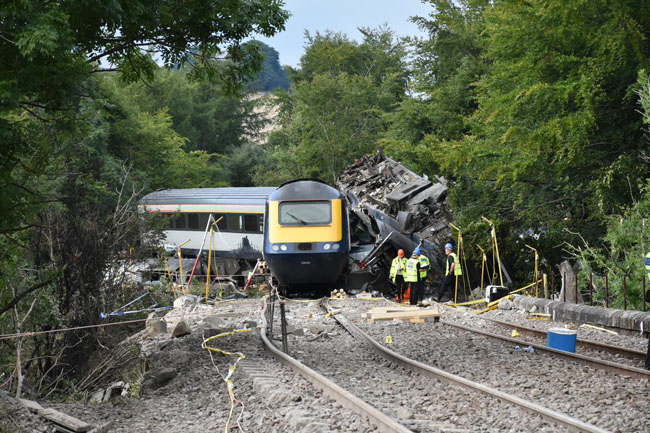Three people died in the August 2020 train derailment in Aberdeenshire after the original designs for a drainage system were not followed – a finding that the Chief Inspector of Rail Accidents said should ‘resonate throughout the UK’s construction industry’.
The Rail Accident Investigation Branch (RAIB) has released its report into the fatal derailment of the train at Carmont on 12 August 2020.
The incident occurred when the train, which was returning towards Aberdeen due to a blockage that had been reported on the line ahead, struck debris that had been washed out of a drainage trench and derailed, then deviated to the left ‘before striking a bridge parapet which caused the vehicles to scatter’.
Three people died as a result of the derailment: the conductor, Donald Dinnie; the train driver, Brett McCullough; and passenger Christopher Stuchbury. The remaining six people on the train were injured.
The RAIB investigation found that the drainage system and associated earthworks ‘had not been constructed in accordance with the original design and so were not able to safely accommodate the water flows that morning’.
It noted that the works were delivered by the now-defunct Carillion and found it unlikely evidence that the changes were to the scheme’s designer, Arup, as should have happened.
The investigation added that Network Rail’s audit regime at the time of the drain’s construction did not include audits likely to detect design modifications implemented without proper change control and that its project team were probably unaware that the drain was significantly different from that intended by the designer.
Chief Inspector of Rail Accidents Simon French said it was ‘sad that a project that was designed for the protection of the travelling public became unsuitable for its intended use and posed a hazard to trains because of such uncontrolled changes to the design’.
He said: ‘This was a tragedy that devastated the lives of the three families who lost their loved ones and brought terror and injury to six other people. We owe it to everybody who was affected by it to strive to learn safety lessons for the future.
‘When anything is built in difficult conditions, such as on the side of a steeply sloped cutting, changes will often be needed for practical reasons. Although such changes are normal and can be highly beneficial in terms of saved time and cost, they need to be made with care. In each case, the original designer needs to understand the change that’s proposed and review the implications of a change that may appear inconsequential to the team on site.
'I hope this example will resonate throughout the UK’s construction industry.’

Image courtesy RAIB
The investigation also noted that the train was travelling at just under the normal speed for the line concerned and that no instruction was given by route control or the signaller that it should be run at a lower speed. ‘At that time there was no written process that required any such precaution in these circumstances. Consequently, normal railway rules were applied to the train movement.’
The RAIB noted that the route ‘had not been given the information, procedures or training that they needed to effectively manage complex situations of the type encountered on the morning’ and also identified that Network Rail’s management processes had not identified or addressed weaknesses in the way it mitigated the consequences of extreme rainfall events.
‘Furthermore, despite an awareness of the risk, Network Rail had not completed the implementation of additional control measures following previous events involving extreme weather and the management of operating incidents.’
The RAIB also observed that the refurbished train that derailed was designed and constructed before standards and design features intended to minimise damage train in case of collision or derailment came into force. It said: ‘While it is not possible to be certain about what would have happened in the hypothetical situation with different rolling stock in the same accident, RAIB considers it more likely than not that the outcome would have been better if the train had been compliant with modern "crashworthiness" standards.’
Mr French added: ‘The tragedy at Carmont is a reminder of just how disruptive and potentially dangerous Britain’s volatile weather can be. The railway industry needs to get even smarter about the way it counters this threat, and to better exploit remarkable modern technology that enables the prediction and tracking of extreme weather events such as summer convective storms.
‘There’s also an urgent need for the railway to provide real-time decision-makers with the information, procedures and training they need to manage complex and widespread weather-related events across the rail network.
‘RAIB doesn’t have all of the answers but is urging the railway industry to think about ways of guiding derailed trains, and to think about the longer-term implications of continuing to operate rolling stock that pre-dates modern standards.’
Network Rail chief executive Andrew Haines said: ‘This report makes clear that there are fundamental lessons to be learnt by Network Rail and the wider industry. As well as expressing our deep sorrow and regret at the loss of the lives of Christopher Stuchbury, Donald Dinnie and Brett McCullough, it’s important that we acknowledge it should not have taken this tragic accident to highlight those lessons. We must do better and we are utterly committed to that.
Register now for full access
Register just once to get unrestricted, real-time coverage of the issues and challenges facing UK transport and highways engineers.
Full website content includes the latest news, exclusive commentary from leading industry figures and detailed topical analysis of the highways, transportation, environment and place-shaping sectors.
Use the link below to register your details for full, free access.
Already a registered? Login